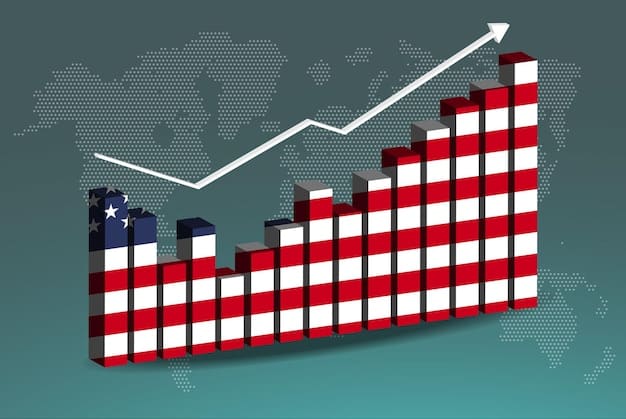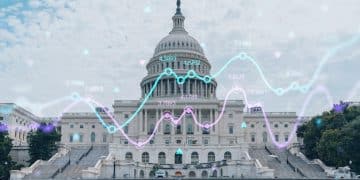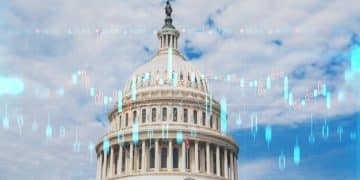Inflation Surge in the US: Key Factors and Expected Duration

Anúncios
The recent surge in inflation within the
The US economy has recently experienced a notable surge in inflation, impacting consumers and businesses alike. Understanding the key drivers behind this surge and projecting its expected duration is crucial for informed financial planning and economic forecasting.
Anúncios
Understanding the Recent Inflation Surge in the US
The recent rise in inflation in the United States has been a significant concern for policymakers, economists, and everyday consumers. Several factors have converged to create this inflationary environment, making it essential to dissect and understand them individually and collectively.
Let’s delve into the primary drivers behind the current inflationary pressures in the US economy.
Anúncios
Demand-Pull Inflation
One of the primary drivers of the recent inflationary surge is demand-pull inflation. This occurs when there is an increase in aggregate demand that outpaces the available supply of goods and services. Several factors have contributed to this increased demand.
- Stimulus Checks: Government-issued stimulus checks provided direct financial assistance to households, boosting consumer spending.
- Pent-Up Demand: After periods of lockdown and restricted spending, consumers were eager to spend, leading to a surge in demand for various goods and services.
- Low Interest Rates: Historically low interest rates made borrowing cheaper, further stimulating demand for big-ticket items like homes and cars.
These factors collectively amplified consumer spending, creating a situation where demand significantly exceeded supply, thereby driving prices upward.

Supply Chain Disruptions
Simultaneous to the demand surge, significant supply chain disruptions have further exacerbated inflationary pressures. These disruptions have created bottlenecks in the production and distribution of goods, leading to shortages and higher prices.
Here’s how supply chain issues have contributed:
- Factory Closures: Lockdowns and outbreaks of COVID-19 led to temporary and sometimes prolonged closures of factories, both domestically and internationally, reducing overall production capacity.
- Shipping Congestion: Ports experienced severe congestion, leading to delays in the delivery of raw materials and finished products. This congestion was partly due to labor shortages and increased import volumes.
- Component Shortages: Shortages of critical components, such as semiconductors, have significantly impacted industries like automotive and electronics, leading to reduced production and higher prices.
These supply chain challenges have made it difficult for businesses to meet the increased demand, thus allowing them to raise prices amid limited availability.
The Role of Monetary Policy
Monetary policy, primarily managed by the Federal Reserve (the Fed), plays a crucial role in influencing inflation. The Fed’s decisions regarding interest rates and asset purchases can either help to control or inadvertently fuel inflationary pressures.
Understanding the Fed’s tools and recent actions provides insight into the current inflationary environment.
Expansionary Monetary Policy
In response to the economic downturn caused by the pandemic, the Fed implemented an expansionary monetary policy. This included:
- Lowering Interest Rates: The Fed reduced the federal funds rate to near zero, making it cheaper for banks to borrow money and, in turn, encouraging lending and spending.
- Quantitative Easing (QE): The Fed engaged in large-scale asset purchases, buying trillions of dollars of government bonds and mortgage-backed securities to inject liquidity into the financial system.
These measures were designed to support economic activity, but they also increased the money supply, which can contribute to inflation if not managed carefully
While the Fed’s actions were intended to stimulate the economy, they also created conditions that fueled inflation, particularly when combined with fiscal stimulus and supply chain issues.

The Fed’s Response to Inflation
As inflation began to rise, the Fed initially characterized it as “transitory,” expecting that supply chain disruptions would eventually ease, and prices would stabilize. However, as inflation persisted, the Fed shifted its stance.
Steps the Fed has taken to combat inflation include:
- Raising Interest Rates: The Fed has begun to raise the federal funds rate, increasing borrowing costs to cool down demand.
- Tapering Asset Purchases: The Fed has started to reduce its asset purchases, gradually decreasing the amount of liquidity it injects into the financial system.
These actions aim to curb inflation by making borrowing more expensive and reducing the money supply. The effectiveness and speed of these measures in bringing inflation back to the Fed’s target of 2% are closely watched.
Impact of Fiscal Policy
Fiscal policy, which involves government spending and taxation, also has a significant impact on inflation. Fiscal stimulus measures can boost demand, while changes in taxation can affect both demand and supply.
Let’s consider the role of fiscal policy in the recent inflation surge.
Government Spending and Stimulus
The US government implemented several large-scale fiscal stimulus packages in response to the pandemic. These included:
- CARES Act: Provided direct payments to individuals, expanded unemployment benefits, and loans to businesses.
- American Rescue Plan: Continued direct payments to individuals, extended unemployment benefits, and provided aid to state and local governments.
These measures injected trillions of dollars into the economy, supporting household incomes and boosting consumer spending. While these were intended to cushion the economic impact of the pandemic, they also contributed to increased demand and inflationary pressures.
Tax Policy
Changes in tax policy can also influence inflation. For example, tax cuts can increase disposable income, leading to higher consumer spending.
Here’s how tax policy relates to inflation::
- Tax Cuts: Lowering income taxes can boost consumer spending and investment, potentially leading to demand-pull inflation.
- Corporate Taxes: Decreasing corporate taxes can incentivize businesses to invest and expand, potentially increasing supply and mitigating inflationary pressures.
The interplay between government spending and tax policies can significantly impact price levels, making fiscal policy a crucial element in managing inflation
Global Economic Factors
The US economy does not exist in isolation; global economic factors also play a significant role in influencing inflation. Events and policies in other countries can affect supply chains, commodity prices, and overall demand.
Let’s examine the key global factors contributing to the recent surge in inflation.
International Supply Chains
Global supply chains are intricate networks that span across multiple countries. Disruptions in any part of these chains can have ripple effects on prices and availability.
Here are some impacts:
- Geopolitical Tensions: Trade wars, sanctions, and political instability can disrupt trade flows and increase the cost of goods.
- Climate-Related Events: Extreme weather events, such as droughts and floods, can damage crops and disrupt agricultural supply chains, leading to higher food prices.
These international supply chain challenges underscore the interconnectedness of the global economy and its susceptibility to various shocks that can exacerbate inflation.
Commodity Prices
Commodity prices, such as oil and metals, are influenced by global supply and demand dynamics. Changes in these prices can have a significant impact on inflation.
Various factors contribute:
- Energy Prices: Increases in oil prices can raise transportation costs and the price of energy-intensive goods and services.
- Metal Prices: Rising prices for metals like copper and aluminum can increase the cost of manufacturing and construction.
These global factors are essential considerations when evaluating the drivers of inflation in the US economy.
How Long Will the Inflation Surge Last?
Predicting the duration of the current inflation surge is a complex endeavor, as it depends on the interplay of the factors discussed above. While exact timelines are uncertain, economists use various models and indicators to make projections.
Understanding these projections can help businesses and consumers plan for the future.
Economic Forecasts
Various institutions and economists have offered forecasts regarding the duration of the inflation surge. Their projections often consider:
- Supply Chain Normalization: Expectations for when supply chain disruptions will ease and production will return to normal levels.
- Monetary Policy Impact: The anticipated effects of the Fed’s rate hikes and balance sheet reduction on demand and inflation.
Most forecasts suggest that inflation will gradually decline over time. However, the pace of decline and the timeline for reaching the Fed’s 2% target vary across different projections.
Potential Scenarios
Several potential scenarios could influence the trajectory of inflation:
- Base Case: Gradual easing of supply chain issues and a moderate cooling of demand due to Fed policy, leading to a gradual decline in inflation over the next one to two years.
- Upside Risk: Persistent supply chain disruptions, coupled with continued strong demand, could lead to higher and more persistent inflation.
- Downside Risk: A sharper-than-expected slowdown in economic growth, potentially triggered by aggressive Fed tightening or external shocks, could lead to a more rapid decline in inflation, possibly accompanied by a recession.
Monitoring economic data and staying informed about these potential scenarios is crucial for managing expectations and making sound financial decisions.
Strategies for Managing Inflation
Given the uncertainties surrounding the duration and intensity of the current inflation surge, businesses and consumers need to adopt strategies to mitigate its impact on their financial well-being.
Here are some effective strategies:
For Businesses
Businesses can take several steps to manage the effects of inflation:
- Diversify Supply Chains: Reduce reliance on single suppliers by diversifying to multiple sources.
- Invest in Efficiency: Improve operational efficiency to reduce costs and minimize the need for price increases.
For Consumers
Consumers can also take proactive measures to protect their purchasing power:
- Budgeting: Create a detailed budget to track expenses and identify areas where spending can be reduced.
- Investing: Consider investing in assets that tend to outperform during inflationary periods.
By implementing these strategies, businesses and consumers can better navigate the challenges posed by inflation and secure their financial futures.
| Key Point | Brief Description |
|---|---|
| 📈 Demand-Pull Inflation | Increased demand outpacing supply due to stimulus and low rates. |
| ⛓️ Supply Chain Disruptions | Factory closures and shipping congestion causing shortages. |
| 🏦 Monetary Policy | The Fed’s interest rate decisions influencing inflationary pressures. |
| 🌍 Global Economic Factors | International supply chains and commodity prices affecting US inflation. |
Frequently Asked Questions (FAQ)
▼
Demand-pull inflation occurs when there is more money available than products and services. This can arise due to increased spending or decreased production, leading to higher prices as demand exceeds supply.
▼
Supply chain disruptions create bottlenecks, leading to shortages and higher input costs for businesses. These costs are often passed on to consumers, increasing prices and contributing to inflation.
▼
The Federal Reserve manages monetary policy to control inflation. They use tools like adjusting interest rates and managing the money supply to keep inflation at a target level, typically around 2%.
▼
Yes, government spending, such as stimulus checks, can boost demand and contribute to inflation. While it can support economic activity, large spending programs can also strain supply and drive up prices.
▼
Consumers can manage inflation by budgeting, reducing unnecessary expenses, and seeking deals. They can also hedge against inflation by investing in assets that tend to perform well during inflationary periods.
Conclusion
Understanding the multifaceted nature of the recent inflation surge in the US economy requires acknowledging the combined effects of demand-pull dynamics, supply chain disruptions, monetary and fiscal policies, and global economic factors. Projecting the duration of this surge involves considering various economic forecasts and potential scenarios, allowing both businesses and consumers to implement strategies for managing its impact. By staying informed and proactive, stakeholders can navigate these challenges and work towards a more stable economic future.





